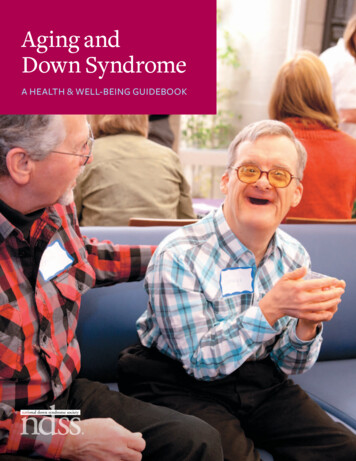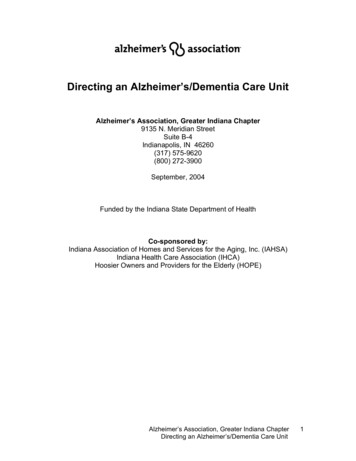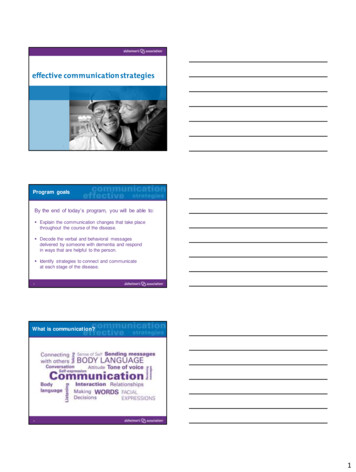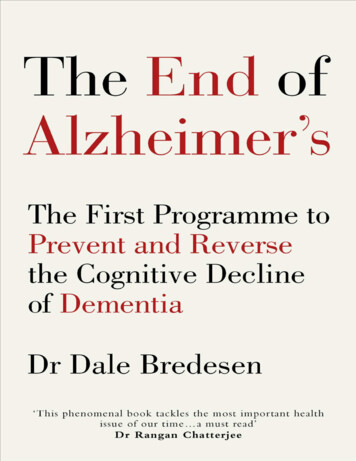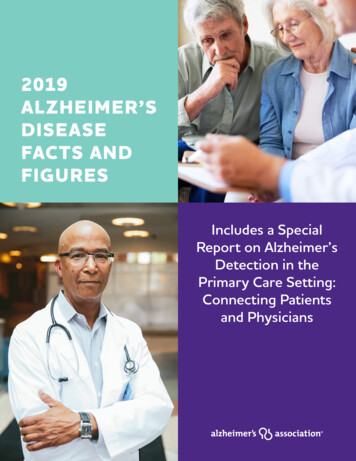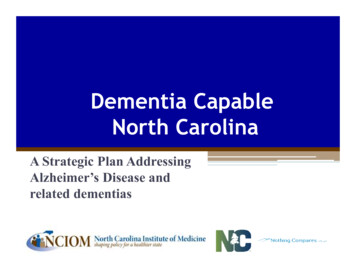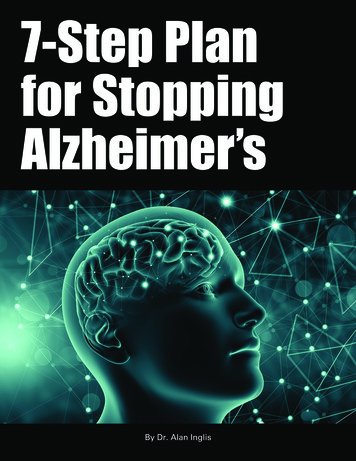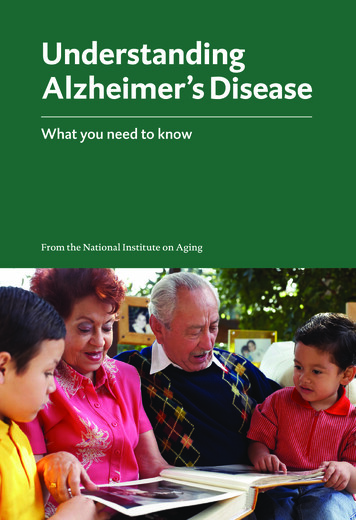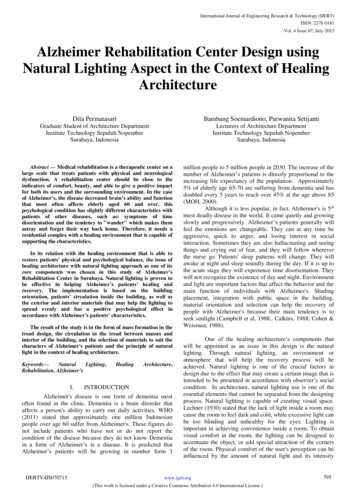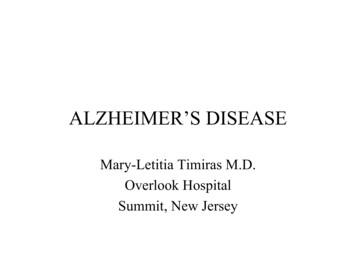
Transcription
ALZHEIMER’S DISEASEMary-Letitia Timiras M.D.Overlook HospitalSummit, New Jersey
Topics Covered DemographyClinical ure trends
Prevalence and Impact of ADAD is the most common cause of dementia in people65 years and olderAffects 10% of people over the age of 65 and 50% ofpeople over the age of 85Approximately 4 million AD patients in the United StatesAnnual treatment costs 100 billionAD is the fourth leading cause of death in the United StatesThe overwhelming majority of patients live at home andare cared for by family and friendsEvans DA. Milbank Q. 1990;68:267-289.Alzheimer’s Association. Available at: www.alz.org/hc/overview/stats.htm. Accessed 5/9/2001.
DIFFERENTIALDIAGNOSIS Alzheimer’s disease Vascular (multi-infarct) dementia Dementia associated with Lewybodies Delirium Depression Other (alcohol, Parkinson's disease[PD], Pick’s disease, frontal lobedementia, neurosyphilis)
DELIRIUM vs DEMENTIA Delirium and dementia often occurtogether in older hospitalized patients; thedistinguishing signs of delirium are: Acute onset Cognitive fluctuations over hours or days Impaired consciousness and attention Altered sleep cycles
VASCULAR DEMENTIA Development of cognitive deficits manifested byboth impaired memory aphasia, apraxia, agnosia, disturbed executivefunction Significantly impaired social, occupationalfunction Focal neurologic symptoms & signs or evidenceof cerebrovascular disease Deficits occur in absence of delirium
DEPRESSION vsDEMENTIA The symptoms of depression and dementia often overlap; patients with primarydepression: Demonstrate motivation during cognitivetesting Express cognitive complaints that exceedmeasured deficits Maintain language and motor skills
Projected Prevalence of AD4 Million AD Cases Today—Over 14 Million Projected Within a 000201020202030Year20402050Evans DA et al. Milbank Quarterly. 1990;68:267-289.
The Progress of Alzheimer’s Disease30Early diagnosisSevereMild-moderateCognitive symptomsMMSE score2520Loss of ADL15105Behavioral problemsNursing home placementDeath00 0.5 1 1.5 2 2.5 3 3.5 4 4.5 5 5.5 6 6.5 7 7.5 8 8.5 9Years
Alzheimer’s Disease ProgressesThrough Distinct y lossLanguageproblemsMood Behavioral, personalitychangesUnable to learn/recallnew infoLong-term memoryaffectedWandering, agitation,aggression, confusionRequire assistancew/ADLSevereGait, incontinence,motor disturbancesBedriddenUnable to performADLPlacement inlong-term careneeded
WHAT IS DEMENTIA? An acquired syndrome of decline in memoryand other cognitive functions sufficient toaffect daily life in an alert patient Progressive and disabling NOT an inherent aspect of aging Different from normal cognitive lapses
Normal Lapses Forgetting a name Leaving kettle on Finding right word Forgetting date ordayDementia Not recognizingfamily member Forgetting to servemeal just prepared Substitutinginappropriatewords Getting lost in ownneighborhood
Normal Lapses Trouble balancingcheckbook Losing keys,glasses Getting blues insad situations Gradual changeswith agingDementia Not recognizingnumbers Putting iron infreezer Rapid moodswings for noreason Sudden, dramaticpersonality change
RISK FACTORS FORDEMENTIA Age Family history Head injury Fewer years of education
THE GENETICS OFDEMENTIA Mutations of chromosomes 1, 14, 21 Rare early-onset (before age 60) familialforms of dementia Down syndrome Apolipoprotein E4 on chromosome 19 Late-onset AD APOE*4 allele risk & onset age in doserelated fashion APOE*2 allele may have protective effect
PROTECTIVE FACTORSUNDER STUDY Estrogen replacement therapyafter menopause NSAIDs Antioxidants
LEWY BODY DEMENTIA Dementia Visual hallucinations Parkinsonian signs Alterations of alertness or attention
Pathology of AD There are 3 consistentneuropathological hallmarks:– Amyloid-rich senile plaques– Neurofibrillary tangles– Neuronal degeneration These changes eventually lead toclinical symptoms, but they beginyears before the onset of symptoms
β-amyloid PlaquesImmunocytochemicalstaining of senile plaquesin the isocortex of a brainof a human with AD (antiamyloid antibody)
Neurofibrillary TanglesImmunocytochemicalstaining of neurofibrillarytangles in the isocortex ofthe brain of a human withAD (anti-tau antibody)
Cholinergic Hypothesis Acetylcholine (ACh) is an importantneurotransmitter in areas of the braininvolved in memory formation Loss of ACh activity correlates with theseverity of ADBartus RT et al. Science. 1982;217:408-414.
Acetylcholinesterase Inhibitors Drugs used to treat Alzheimer’s disease act byinhibiting acetylcholinesterase activity These drugs block the esterase-mediatedmetabolism of acetylcholine to choline andacetate. This results in:– Increased acetylcholine in the synaptic cleft– Increased availability of acetylcholine forpostsynaptic and presynaptic nicotinic(and muscarinic) acetylcholine receptorsNordberg A, Svensson A-L. Drug Safety. 1998;19:465-480.
Acetylcholinesterase InhibitionAcetic acidCholine AChE inhibitorPresynapticnerve lNicotinicreceptorAcetylcholine(ACh)Nordberg A, Svensson A-L. Drug Safety. 1998;19:465-480.Acetylcholinesterase(AChE)
ASSESSMENT: HISTORY(1 of 4) Ask both the patient & a reliable informant about the patient’s: Current condition Medical history Current medications & medication history Patterns of alcohol use or abuse Living arrangements
ASSESSMENT: PHYSICAL(2 of 4) Examine:Neurologic statusMental statusFunctional status Include: Quantified screens for cognition– e.g., Folstein’s MMSE, Mini-Cog Neuropsychologic testing
ASSESSMENT:LABORATORY (3 of 4) Laboratory tests should include: Complete blood cell count Blood chemistries Liver function tests Serologic tests for:Syphilis, TSH, Vitamin B12 level
ASSESSMENT: BRAINIMAGING (4 of 4) Use imaging when:Onset occurs at age 65 yearsSymptoms have occurred for 2 yearsNeurologic signs are asymmetricClinical picture suggests normal-pressurehydrocephalus Consider:Noncontrast computed topography head scanMagnetic resonance imagingPositron emission tomography
Treatment of Alzheimer’s DiseasePatients evalence DiagnosedTreated** Any drug treatment, not limited to acetylcholinesterase inhibitors.Source: Decision Resources, March 2000.Treatedwith AChEIs
TREATMENT &MANAGEMENTPrimary goals: to enhance quality oflife & maximize functional performanceby improving cognition, mood, andbehavior– Nonpharmacologic– Pharmacologic– Specific symptom management– Resources
NONPHARMACOLOGIC Cognitive enhancement Individual and group therapy Regular appointments Communication with family,caregivers Environmental modification Attention to safety
PHARMACOLOGIC Cholinesterase inhibitors: donepezil,rivastigmine, galantamine Other cognitive enhancers: estrogen,NSAIDs, ginkgo biloba, vitamin E Antidepressants Antipsychotics
SYMPTOMMANAGEMENT Sundowning Psychoses (delusions,hallucinations) Sleep disturbances Aggression, agitation Hypersexuality
RESOURCES FORMANAGING DEMENTIA Attorney for will, conservatorship, estateplanning Community: neighbors & friends, aging &mental health networks, adult day care, respitecare, home-health agency Organizations: Alzheimer’s Association, AreaAgencies on Aging, Councils on Aging Services: Meals-on-Wheels, senior citizencenters
SUMMARY (1 of 2) Dementia is common in older adults but is NOTan inherent part of aging AD is the most common type of dementia,followed by vascular dementia and dementiawith Lewy bodies Evaluation includes history with informant,physical & functional assessment, focusedlabs, & possibly brain imaging
SUMMARY (2 of 2) Primary treatment goals: enhance quality oflife, maximize function by improvingcognition, mood, behavior Treatment may use both medications andnonpharmacologic interventions Community resources should be used tosupport patient, family, caregivers
Future Trends Alzheimer’s as a multifactorial syndromePendulum of historyVaccineGenetic therapy
SUMMARY (1 of 2) Dementia is common in older adults but is NOT an inherent part of aging AD is the most common type of dementia, followed by vascular dementia and dementia with Lewy bodies Evaluation includes history with informant, physical & functional assessment, focused labs, & possibly brain imaging

